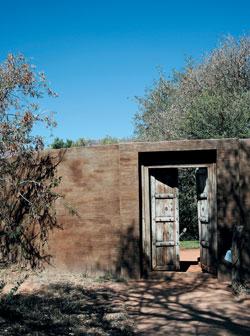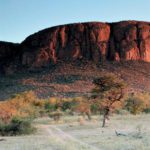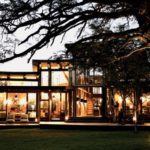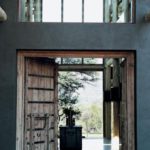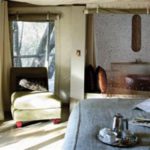KIM HOEPFL visits Marataba Safari Company in Limpopo and finds that it fits securely into a new generation of hotels – in trend with the vanguard of modern design and as welcoming as it is beautiful
KIM HOEPFL
This is frontier country, with the Botswana border not far away. The lodge, which made the Condé Nast Traveller 2007 hotlist, awarded to their choice of the world’s most hip and beautiful hotels, is neither pretentious nor over the top. It’s a gentle place, soothing for the soul. Here the earth, with you alongside it, takes one long, deep breath.
Rooms, accessed by long, winding sand walkways, are ingenious tented structures, where layers of creamy canvas are kept taut with a series of cantilevers and pulleys, but still remain loose enough to make soft billowing sounds when the breeze blows. Languid gusts of warm air flow freely above each tent’s pinnacled ceiling and mesh side windows, both well suited to dealing with the heat endemic to this part of the country.
Flanking each tent is a veranda of wooden decking, hedged with a balustrade of wild wood as curvaceous in design as the rounded forms of the tent. Not taking things too seriously, leisurely seating is provided in the form of beanbags. This is smart from a comfort point of view, because guests can pummel them into shapes that suit them perfectly. From this perch, one is invited to spend languid hours gazing out at the massive Kransberg mountains beyond, which glow orange at sunset. The sound of trickling water pervades the air here like a gentle, soft perfume, incongruous in this hot, dry place.
Upon arrival, visitors are transported from their dusty, sundrenched entrance to instant cool, by a powerful sheet of water. It plummets over the wall to the side of the walkway, taking you into the body of the lodge, where the water’s reflection plays constantly on the interior walls. Continuing the theme of water -induced calm, outside each room is a stone vat, filled with water animated by a small fountain. At night, its gentle burble mingles with the chirrup of insects that cascades in through the mesh windows of the tents.
Rooms are not lavish, neither are they spare, but somewhere in between. They are cool and spacious, their canvas ceilings drawn to a point like a Bedouin tent, and they glow welcomingly when lamps are switched on at night. Mattresses are firm and decked in pillows, ideal for laying one’s head against and reading a book on a long lazy afternoon.
Attention is paid to light, different combinations of which can be adjusted to suit the mood with the flick of a switch, and constant airflow. Bathing is a pastime to which you can devote yourself entirely. Bathrooms are almost as large as the bedrooms. The focal point is the bath, ovalshaped, the colour of bronze and positioned directly in front of two sliding doors that peel away to reveal the bush beyond. You can easily languish here for a while, staring at the sunset and soothed by the scent of bath crystals.
During my stay here I mistakenly thought I would “sleep in”, calling for a tray of hot tea to be brought to my room at 7:30am, about an hour after the departure of the morning game drive. How wrong I was. You would have to be impervious to the sounds of the bush, or just deaf, to pull that off. What the animals, antelope mostly, don’t get up to in the torpid heat of the day, they make up for in the earliest hours of the morning. As the sun rises, so do they. My visit coincided with the rutting season of impala, when they emit a loud snort to mark their territory.
Marataba is alive with them, and this snorting conversation was audible from all corners of the camp. Resident vervet monkeys are also full of beans at this hour and love galloping the length of the canvas roof of the tent, chattering all the while and then swinging into the adjacent trees with a loud whoosh sound. Now firmly awake, I had a choice: to languish in the deep bath, take an inside shower or, step outside to the open-air shower and let the water gush over me like rain.
Thoroughly warm, I wrapped myself in a big, thick towel and pattered inside to get dressed. The rest of the day is yours. It’s difficult not to curl up with a good book and let your mind slip into neutral; or do some serious birding (there are about 350 different bird species in the area), all of which can be done from the comfort of your beanbag on the veranda, a hammock slung between the trees, or next to the crystalline pool.
Then of course, there is always lunch to look forward to, and afternoon tea and dinner. Food from chef Brigitte Rosemann and her team is a highlight, understated and delicious. Breakfast fruits (pineapple, guava, pawpaw) procured from the area are sensational, almost surreal in their pure, sweet flavours.
Meals alternate, with a formal lunch and informal dinner one day, and informal lunch but formal dinner the next. Lunches are served beneath the thorn trees on the lawn. When informal, they consist of a set menu of small, different dishes delivered on a platter, all at once. It’s food served at room temperature and designed to be picked at, glass of wine close at hand: a tomato, cucumber and mint salad, watercress dressed in yoghurt, warm wedges of chicken and harissa sauce baked in phyllo, a small bowl of olives and feta.
A formal dinner, by contrast, is more lavish, with an à la carte menu of four separate courses, including a fun palate cleanser (gin and apple slush). The winelist is concise but thoughtfully put together and includes a selection of white and red wines and bubbly, some available by the glass. The staff at Marataba seem to be genuinely happy people, and it shows. The competent ease with which they perform their job and bright-smiled enthusiasm make them easy to engage with. It’s so easy to relax here, in the sense of just being yourself and letting them pamper you: with their food, with their willing service, their easy-going flexibility.
Even the animals take it easy– warthogs wander right into camp for a quick snuffle and to rip up the lawn. While understated, it’s not difficult to see where Marataba earned its place on the hotlist for 2007, the indicators of which are service, good food and comfort.
CONTACT DETAILS
Marataba is a Relais & Châteaux member, a grading network that spans 456 properties (hotels and restaurants) in 51 member countries, rating them according to “courtesy, charm, character, calm and cuisine”. Visit www.relaischateaux.com for more information.
SOURCES
ELSA YOUNG

